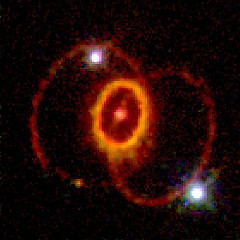

|
The International Conference
|
Abstract The existence of strange quark stars has been proposed many years ago. More recently, the possible co-existence of a first family composed of "normal" neutron stars with a second family of strange quark stars has been proposed as a solution of problems related to the maximum mass and to the minimal radius of these compact stellar objects. We studied the mass distribution of compact objects formed in binary systems and the relative fractions of quark and neutron stars in different subpopulations. According to our results, the main channel for strange quark star formation in binary systems is accretion on a neutron star. The number of double strange quark star systems is rather small with only a tiny fraction which merge within a Hubble time. This drastically limits the strangelets' pollution, and it rules out at least one relevant channel for the transformation of all neutron stars into strange quark stars.
Reference:
|